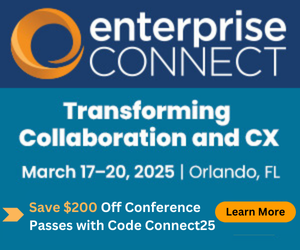Interaction Analytics Matter – A LotInteraction Analytics Matter – A Lot
LLMs deliver compelling insights to improve CX and business operations.
February 6, 2025

Embedded in every conversation or interaction with a customer are valuable insights that CX and business leaders should cultivate to improve everything from product innovation to operational efficiency to customer satisfaction.
Today, only 50% of companies are using interaction analytics products to uncover, analyze, and/or act upon that data, according to Metrigy’s CX Optimization 2024-25 global study of 544 companies. This figure will continue rising as generative AI-powered analytics deliver information and recommendations that ultimately drive a very quick payback.
Here are just a few areas of measurable value with interaction analytics:
Contact center supervisors can understand how agents are performing and what deficiencies require hands-on coaching or AI-based training.
Technology analysts can analyze which interaction channels, applications, or services are correlating with the highest and lowest customer satisfaction—and adjust deployments as warranted.
Sales leaders can rely on the analytics to evaluate word choices, time spent listening vs. talking, length of conversations, sentiment, and more to more accurately place opportunities in sales pipelines. They also can use the information to coach salespeople and teams to help improve close rates.
Product managers can interact with the analytics interface to determine updates and revisions that will meet customer demand and have the most impact on revenue and customer satisfaction.
Any business leader can rely on the analysis for operational efficiencies—frankly, anywhere in the organization as both vendors and businesses get more creative in how they deploy the products.
Far-Reaching Market
Cresta introduced a sophisticated agentic AI product, AI Analyst, that lets CX and operations leaders ask questions in a natural language interface and receive near-real-time insights from customer conversations. What’s more, its LLM evaluates the words, mentions, and sentiment from each conversation individually vs. collectively so the results and analysis are more statistically valid.
Other companies, including Calabrio, CallMiner, Five9, NICE, UJET, Verint, Spearfish.ai, and Zoom, offer interaction analytics, each with varying degrees of sophistication and relevance. Those with contact center platforms often integrate the findings directly to real-time service or sales agent guidance. Other specialized providers focus more on operations teams or even workforce engagement management integration.
Contact center leaders already are measuring the success of such products. For example, one of Cresta’s global customers was spending 1,600 hours per year on manually analyzing conversations. Analysis on a single topic took 160 hours, leaving the company to do only about 10 analyses each year. Now, a company can get results within minutes for any analysis it needs— and the company can continue to drill down, using natural language to ask specific questions, and the answers will appear within minutes.
The ability to continue to ask questions and drill down into the root cause of a trend or to excavate the details of a customer conversation can help elevate decisions because they are based on data vs. best guesses. This is one of the top reasons I’m so bullish on this category of AI products.
Generative AI’s Important Role
Not surprisingly, generative AI Large Language Models (LLMs) are the catalyst for interaction analytics rising to new levels. LLMs can quickly analyze extremely large volumes of data, including call transcripts, recordings, videos, and screen-sharing, to produce these meaningful insights.
Without the use of LLMs, companies can gather static insights from calls or data analysts can manually evaluate the data. However, static insights are just that—business leaders can’t query the findings to learn more, at least not in anything close to real-time. With the LLMs, business leaders can dive into the data, pelting it with questions that ultimately result in valueable information or actionable advice Of course, knowing what questions to ask is not a universal skill, and that’s where prompt engineering comes into play. Companies can train those who use LLMs in this manner on how to craft the best prompts for the most valuable answers, and increasingly, technology providers are developing prompt templates for common question types.
Even with prompt training or templates, business and CX leaders may or may not know what they want to ask the interface. As the saying goes, they don’t know what they don’t know. So, they rely on the LLMs to discover issues, patterns, or trends that are emerging, enabling them to stay updated on the happenings in their company and prompting them to act if needed.
Expansive Potential
For now, these types of interfaces are largely geared toward the low-hanging fruit—customer conversations. But moving forward, I see no reason they can be expanded to other areas of the company (IT, HR, front line employees, etc.) to uncover operational inefficiencies, high and low performers, and outcomes of marketing campaigns, new product launches, and more.
I believe executive-level dashboards will become a staple in the C-suite, because they will enable key decision-makers to identify key metrics worth tracking and then acting upon them when trends develop. For example, if multiple customers start complaining about the same defect in a product, communications and customer service teams can hedge the fallout by reaching out proactively and providing a fix before a viral social media post causes huge financial problems and longstanding reputational issues.
This type of interaction with live customer data can be a game changer for companies that use it to its fullest—and most importantly, act on the findings.
About the Author
You May Also Like





